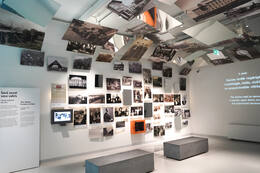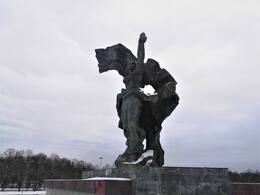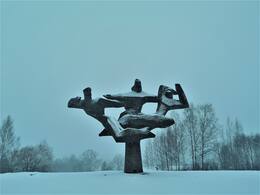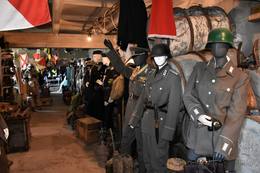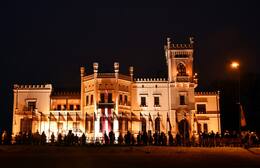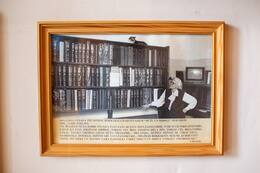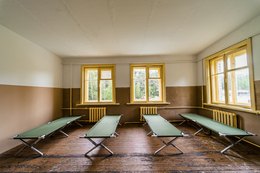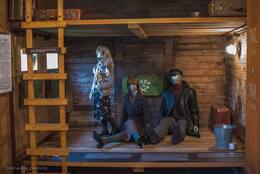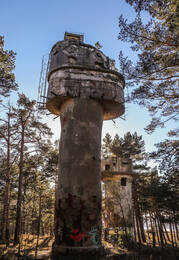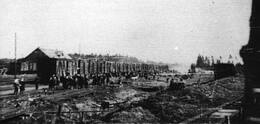Totalitarism
II Maailmasõda, IV Nõukogude okupatsioon
Totalitarism (ladina keelest totalis 'comprehensive'; inglise Totalitarianism, German Totalitarianism, French totalitarism, Russian totalitarism) - poliitiline süsteem, milles riiki juhitakse ilma avalikkuse osaluseta, totalitarismi puhul tehakse otsuseid ühiskonna enamuse nõusolekuta; olulisemad sotsiaalsed, majanduslikud ja poliitilised tegevused totalitaarses režiimis on riigi kontrolli all. See on diktatuuri vorm, kus võim piirab inimesi kõigis sfäärides. Diktatuuri tingimustes kuulub võim väikesele inimrühmale või isegi ühele inimesele. Iseloomulikud tunnused: riigivõim on koondunud kitsa grupi – kliki kätte; opositsiooni mahasurumine, üldine terror kui avaliku halduse tööriist, kõigi eluvaldkondade allutamine riigi huvidele ja valitsevale ideoloogiale; püsivalt mobiliseeritud ühiskond juhikultuse, massiliikumiste, propaganda jne kaudu; agressiivne, laienemisele orienteeritud välispoliitika; täielik kontroll avaliku elu üle.
Lätis jaguneb totalitaarsete režiimide aeg kronoloogiliselt 3 etappi: 1) NSV Liidu esimene okupatsioon 17. juunist 1940 kuni juulini 1941; 2) Natsi-Saksamaa okupatsioon juulist 1941 kuni sügiseni 1944 (Kurzemes kuni 1945. aasta maini); 3) teise Nõukogude okupatsiooni periood 1944. aasta sügisest kuni Stalini surmani 1953. aastal.
Totalitarismi mõiste autor on Itaalia publitsist-antifašist Giovanni Amendola. 1925. aastal võttis selle termini üle Itaalia peaminister ja diktaator Benito Amilcare Andrea Musolini ning fašistid hakkasid seda nägema oma poliitilise süsteemi terminina. "Totalitarismi" idee võtsid Itaalia fašistidelt üle saksa parempoolsed intellektuaalid, nagu filosoof Carl Schmitt, liberalismi ja liberaalse riigi kriitik.
Akadeemilistes ringkondades käib arutelu selle üle, milliseid režiime võib pidada totalitaarseteks. Üldiselt ollakse üksmeelel, et need on 20. sajandi režiimid Natsi-Saksamaal (1934-1945), NSVL-s Stalini ajal (1929-1953), Hiinas Mao Zedongi valitsusajal (1949-1976), Demokraatlikus Rahvavabariigis. Korea (Põhja-Korea) Kim (dünastia (1948 - praegu)) ja Paul Poti režiim Kambodžas (1976-1979).
Rohkem teabeallikaid
Daina Bleiere. Totalitarism. Rahvuslik entsüklopeedia. https://enciklopedija.lv/skirklis/51186
Totalitarism. Vikipeedia. https://en.wikipedia.org/wiki/Totalit%C4%81risms
Seotud ajajoon
Seotud objektid
Läti Okupatsiooni-muuseum
Muuseumis eksponeeritakse Läti ajalugu Natsi-Saksamaa ja Nõukogude Liidu okupatsiooni ajal aastatel 1940–1991. „Tuleviku maja“ on okupatsioonimuuseumi rekonstrueerimis- ja laienemisprojekt, mille autor on Ameerikas elav tuntud läti arhitekt Gunārs Birkerts, ning sellega seotud uus muuseumiekspositsioon. Okupatsioonimuuseumi väljapanek „KGB ajalugu Lätis“ asub KGB-hoones (Nurgamajas). Läti Okupatsioonimuuseum asutati 1993. aastal. See jutustab pikka aega varjatud loo Läti riigi, rahva ja maa saatusest kahe võõrriigi totalitaarse okupatsioonivõimu all aastatel 1940–1991. 2020. aasta lõpus kuulus muuseumikogusse üle 70 000 ajaloolise eseme (dokumendid, fotod, kirjalikud, suulised ja materiaalsed tõendid, esemed ja mälestusesemed). Muuseumi spetsialistid on salvestanud rohkem kui 2400 videomälestust, mis teeb sellest ühe suurima okupatsiooni käsitleva kogu Euroopas. Lätis, Leedus ja Eestis toimunud sündmused näitavad meile selgelt, mida need rahvad pidid kahe totalitaarse režiimi all kogema.
Võidu park
Asub Riias, Pārdaugavas, Läti Rahvusraamatukogu lähedal.
Võidu park on üks suurimaid ja vastuolulisemaid parke Lätis. See võtab enda alla 36,7 ha suuruse territooriumi, kuhu loodi Nõukogude okupatsioonivõimu ülistav monumentaalansambel "Nõukogude Läti ja Riia saksa fašistlikest sissetungijate käest vabanenutele". Ehitatud kohta, kus 17. saj kindlustused ja oli viimane teadaolev avalik hukkamise koht Lätis.
20. sajandil alguses loodi kunagise Kobroni skansti territooriumile maastikupark. See on pühendatud Vene keisrile Peeter I-le, kelle armee vallutas 1710. aastal Riia. Pärast Läti riigi loomist kavandati territooriumile ambitsioonikas projekt - Võidu park. See oli mõeldud Vabadussõja kangelaste aukohaks, Läti riigi suuruse ja enesekindluse sümboliks. Avalike annetuste toel rajatud park oli mõeldud suurürituste korraldamiseks, kuid Teine maailmasõda katkestas plaani.
Nõukogude okupatsiooni ajal sai pargi territooriumist 7 Saksa armee ohvitseri hukkamise koht. Märkimisväärne sündmus oli 1985. aastal Baltimaade suurima Nõukogude võimu ja selle sõjaväge ülistava objekti avamine.
Kuni 23.08.2022. g. (lammutatud) oli võimalik tutvuda monumentaalansambliga, mis esindas Nõukogude Liidus valitsevaid monumentide ehitamise suundi. Lai pargiala sobib suurepäraselt jalutuskäikudeks ja aktiivseks puhkuseks.
Vabadussõjalaste monument
See asub Tukumas, Mālkalnas, Jelgavas tänav 15A.
Monument avati 1975. aastal, et rõhutada Punaarmee teeneid Teise maailmasõja ajal. See toimis nõukogude ideoloogia ja propaganda vahendina, tugevdades sümboolselt okupatsioonirežiimi kohalolekut Lätis ja luues müüdi nõukogude kui "vabastajate" kohta. Monumendi autor on skulptor ja Tukumsi Arta dumpe elanik.
Pärast Saksamaa kapituleerumist 8. mail 1945 tajus Punaarmee Kurzemit vaenlase käest vallutatud territooriumina, mitte NSVLi vabastatud osana. Kuramaa elanikud olid vaenlased ja nende vara peeti sõjatrofeedeks. Repressiivvõimud ja sõjavägi alustasid "Kurzeme puhastamist". 16-60-aastased mehed peeti kinni, registreeriti ja kontrolliti. Ohu poolest võrreldi Kuramaa elanikke - mehi - kapituleerunud Saksamaa sõjaväelastega. Algas punaarmee lubadus ja kuritegude laine – mõrvad, vägistamised, röövimised, arreteerimised ja "inimeste kadumised". Ainus relvastatud vastupanu oli rahvuslikest geriljarühmitustest. Nõukogude võim lõi võitluspataljone, sealhulgas Tukumi rajooni, et kõrvaldada igasugune vastutegevus. Vägivalla- ja terrorilaine saavutas haripunkti 1949. aastal, mil elanikkond küüditati kogu Lätis.
Täna saab monumenti näha. Selle sümboolset tähendust seletatakse erinevalt – lahingustseen või ema, kes hoiab poegi kinni, võitlemas vastaspooltel. Monument on paigaldatud muljetavaldava vaatega künkale.
Erasõjaväe kollektsioon Mundigciemsis
Erasõjaväe kollektsioon Mundigciemsis. Aivars Ormanis on aastaid kogunud ajaloolisi esemeid - sõjaväe vormiriietust, vormiriietust, kamuflaaži, sidevahendeid, majapidamistarbeid, kaitsevarustust erinevatest perioodidest ja riikidest, alates Teisest maailmasõjast, Nõukogude armeest ja iseseisva Läti taastamisest.
Praegu ei ole kollektsioon hästi hooldatud ja eksponaadid asuvad endises kolhoosiaidas.
Alūksne muuseum
Alūksne muuseum asub 19. sajandi lõpus uusgooti stiilis ehitatud Alūksne Uues Lossis, mis on riiklik arhitektuurimälestis. Muuseumis on välja pandud näitused „Totalitaarse režiimi ohvrite mälestustuba”, mis jutustab Alūksne valla elanike saatusest Siberis ja Kaug-Idas, ja „Ajastute pidusöök“, mis tutvustab Alūksne ajalugu eelajaloost tänapäevani. Eraldi väljapanek on pühendatud 7. Sigulda jalaväepolgu panusele sõjas, kultuuris ja ühiskonnaelus. 7. Sigulda jalaväepolku hakati moodustama 20. juunil 1919 Naukšēni mõisas. Esialgu moodustati Põhja-Läti Brigaadi reservpataljoni põhjal lahingurühm, kuhu kuulus 22 ohvitseri ja 1580 sõdurit; seda kutsuti Dankersi diviisiks. See kuulus 3. Jelgava polgu 2. pataljoni koosseisu, aga pärast 23. augustit, mil täiendati roodude arvu, 7. Sigulda jalaväepolgu koosseisu. Polk võitles Bermondti vastu ning viidi 5. jaanuaril 1920 üle Latgale rindele enamlaste vastu võitlema. Pärast rahulepingu sõlmimist Nõukogude Venemaaga valvas polk Läti idapiiri. Läti Vabadussõjas kaotas elu üle 200 polgu sõduri, 85 sõdurile anti Karutapja orden. 1921. aastal paigutati 7. Sigulda jalaväepolk Alūksnesse. Polgu staap seati sisse Alūksne Uues Lossis. Pärast Teist maailmasõda võtsid lossi üle Nõukogude julgeolekuasutused. Alates 1950. aastate lõpust on seal tegutsenud kultuuriasutused: täitevkomitee kultuuri- ja kinematograafiaosakond, pioneerimaja, raamatukogu, kino ja muuseum.
Melānija Vanaga muuseum ja Siberi muldonnMelānija Vanaga muuseum ja Siberi muldonn
Kirjanikule ja kultuuriloolasele Melānija Vanagale pühendatud muuseum asub Amata külakoolis Võnnu (Cēsise) vallas. Muuseumis on välja pandud materjalid Vanaga elu, kirjandusliku tegevuse, suguvõsa ja saatuse kohta, seal on videomaterjalid Siberi ja sinna küüditatud lätlaste kohta ning Siberi muldonn, mis viib külastajad rännakule kirjaniku küüditamispaika Krasnojarski krais Tjuhteti rajoonis. Muldonni välimus ja sisseseade annavad realistliku ettekujutuse elust võõrsil. Muldonnis eksponeeritakse ainulaadseid ajaloolisi esemeid, mis on toodud Tjuhteti muuseumist: kasetohust nõu, savikruus ja petrooleumilamp. Muuseumis võib vaadata videointervjuusid piirkonna poliitiliselt represseeritud elanikega ja Melānija Vanaga raamatu „Veļupes krastā“ (Hingede jõe kaldal) kaheksateistkümne tegelasega. Muuseumi virtuaalne näitus „OLE SINA ISE!” (http://esipats.lv) avab viie küüditatud lapse ja nende vanemate kogemust, keda nõukogude võimud süüdistasid alusetult kodumaa reetmises.
Nõukogude armee sõjaväebaas Pāvilostas - aktiivne puhkekeskus
Nõukogude ajal asus siin piirivalveüksus, mõned kilomeetrite kaugusel metsas asusid teised nõukogude armee üksused - sideohvitserid ja maa-õhk tüüpi raketibaas. Pärast iseseisvumist paigutati sinna Läti armee.
Endine Nõukogude armee sõjaväebaas on nüüd puhke-, puhke- ja matkakeskus - isikliku arengu jaoks looduse ja ümbritsevate inimestega suhtlemisel.
Puhke- ja majutuskoht nii turismigruppidele kui ka peredele. Toad, duššid, WC, kaminad, avar ala tegevusteks, loodushääled. Broneerige eelnevalt telefonil +371 26314505.
Küüditamiseks kasutatud karjavagun - muuseum Skrunda raudteejaamas
1941. aasta juuniküüditamise ja 1949. aasta märtsiküüditamise mälestuseks on Skrunda raudteejaama juurde püstitatud mälestuskivi ja neljateljelisse vagunisse sisse seatud muuseum. See on esimene vagunimuuseum Lätis, kus on püsiekspositsioon: fotod, kirjad, memuaarid, dokumendid ja küüditatud inimeste valmistatud esemed. Skrunda jaam oli koht, kuhu välja saadetavad inimesed kokku koondati, ja üks kolmest piirkonnajaamast, kuhu toodi inimesi Skrunda ja Kuldīga ümbruskonnast. 1941. aastal küüditati siit Siberisse Krasnojarski kraisse hiljem taasiseseisvunud Läti Vabariigi esimeseks presidendiks saanud Guntis Ulmanise perekond.
Karosta, Liepāja sõjasadam (ekskursioon)
Karosta on Baltimaade suurim ajalooline sõjaväeala, mis hõlmab peaaegu kolmandiku kogu Liepāja territooriumist. Karosta on ainulaadne sõjaväe- ja kindlustushoonete kompleks Läänemere kaldal, mis on eriline Läti ja kogu maailma ajaloos ja arhitektuuris. Karostas asuvad sellised militaarpärandi objektid nagu Põhjamuul ja -fordid, redaan, Karosta vangla, Karosta veetorn, Püha Nikolai õigeusu merekatedraal ja Oskars Kalpaksi sild.
Pāvilosta Koduloomuuseumi püsinäitus
Pāvilosta Koduloomuuseumis võib vaadata näitust „Pāvilosta, suletud ala”, mis räägib elust Pāvilostas Nõukogude okupatsiooni aastatel: täitevvõimust, piiritsoonist, kalurikolhoosist, kultuurielust ja olmest. Lisaks püsiekspositsioonile on välja pandud interaktiivne tundeküllane diginäitus kahes keeles ning audiovisuaalne installatsioon filmiga Pāvilostast.
Lisaks on muuseumis välja pandud uus näitus „Pāvilosta kuldsed liivaterad”. Digitaalne väljapanek tutvustab ammuseid sündmusi, Pāvilosta kujunemist ja tähtsamaid arenguid alates 1918. aastast tänapäevani. Militaarpärandit puudutatakse vabadusvõitlejatest rääkivas Läti Vabadussõja sektsioonis ja Nõukogude okupatsiooni sektsioonis.
Mälestuskivi Stende raudteejaamas
Ventspilsi-Mazirbe raudteeliin, samuti Stende-Dundaga pikendus Mazirbesse koos haruga Pitragsi, oli ette nähtud ainult strateegiliste sõjaliste vajaduste rahuldamiseks. Nende liinide ehitamise ajal ja pärast seda evakueeriti kõik tsiviilelanikud piirkonnast. Irbe väina piirkonnas asuvate sõjaliste raudteede peamine ülesanne oli Saksa armee rannikukaitsepositsioonide varustamine relvade ja laskemoonaga.
Need ainult sõjaväe kasutuses olevad sõjaväe raudteed ühendasid ka kolme kõige tähtsamat tuletorni, mis asusid Ovišis, Mikeltornis ja Šlīteres.
Sellest hoolimata korraldati juba I maailmasõja aastatel ka reisijatevedu.
Stende raudteejaamas asub mälestuskivi (1989) 1941. ja 1949. aastal küüditatud lätlastele.
30. oktoobril 1919 hõivasid Stende raudteejaama Bermonti väed. 17. novembril ründasid K. Šnēbergsi juhitud Läti sõjaväe sõdurid jaama, ajades ära vagunid relvade, sõjavarustuse ja viljaga. Nende lahingute eest pälvisid 6 sõdurit ordeni: K. Bumovskis (1891-1976), P. Strautiņš (1883-1969), R. Plotnieks (1891-1965), E. Jansons (1894-1977).
Seotud lood
1949. aastal Skrunda jaamas salaja pildistatud küüditamise ešelon
25. märtsil 1949 nägi Skrunda õpilane Elmārs Heniņš, kuidas tema klassikaaslased ära viidi. Ta võttis oma fotoaparaadi ja ronis lähedalasuval mäel asuvale männipuudele, et dokumenteerida toimuvat, hiljem aga peitis pildid.
Kolka rannavalve vaatetorn
Piirivalvetorn on peidetud Kolka neeme viimastesse mändidesse, kus NSV Liidu ajal pidevalt asus piirivalvepost ja selle kõrval olev väike kiviaed on nüüd mahajäetud ja saatust hävitav.
23. veebruaril 1946 toimunud lahing Zūru meža Dzelzkalni ümbruses
1945/46. Misiņa rühm veetis 2010. aasta talve Zūru metsas Dzelzkalni piirkonnas, kuhu oli ehitatud mitu punkrit. Siia jäi umbes 40 partisani. 23. veebruaril 1946 piirati laager NSV Liidu sisevägede poolt ümber ja toimus äge lahing.
Partisanidena 1945/1946 ajas okupandid Kabülist välja
Partisanidena 1945/1946 ajas okupandid Kabyle'ist välja / Artikkel (lsm.lv)
Pēteris Čevers - rahvuslik partisan ja partisanide rühma ülem.
Pēteris Čevera - rahvuslik partisan ja rahvusliku partisanirühma ülem.
Endise leegioni leitnandi Arvīdas Gailīši roll Pēteris Cheveri rühma likvideerimisel
Kapten Pēteri Čevera ja veel seitse partisani tabati 1. novembril 1950 Engure metsamassiivis, kuhu endise leegionileitnandi Arvīdas Gailīši (agent-võitleja hüüdnimi "Grosbergs") võltspartisanide rühmitus oli juhuslikult paigutanud. Sinna kuulusid LPSR VDM-i töötajad ja "metsavendade" rolli täitnud agent-sõdurid.
Maandus Leonid Zariņš – tšekk osutub värbamisel kasutuks
Leonid Zariņš värvati USA-s CIA agendiks ja 1953. aastal ületas ta Saksamaalt lennukiga NSV Liidu piiri ja maandus langevarjuga Auce lähedal. Kahjuks oli üks kontaktidest, kellega ta pidi suhtlema, osutunud topeltagentiks ja Leonidas arreteeriti peagi. Ta keeldus tšekistidega koostööd tegemast ja lasti 1954. aastal ilma kohtuta maha.






